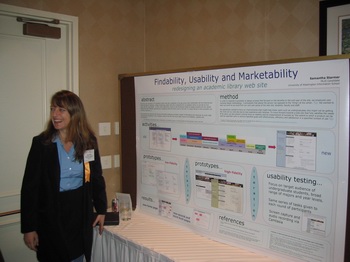
Talking about my poster at the recent ASIS&T
(American Society of Information Science and Technology)
national conference in Providence, RI.
Why…
What is a poster session? Why should you care? Even if you have a sneaking suspicion that this kind of poster session is not about showcasing your old Duran Duran memorabilia, it can be hard to figure out what exactly a poster session is and why you might be interested in doing one. The general purpose of a poster session is to advertise your research. Poster sessions usually occur at a professional conference, seminar or other forum where lots of researchers are in attendance. However, depending on the type of conference, poster sessions are often much more practitioner based, possibly showcasing a case study or some experimental work being done in a setting other than academia.
While it generally seems that PhD students and faculty are the ones doing poster sessions, it is definitely something a Masters or undergraduate student can accomplish, and I wish that the opportunities were more advertised at the iSchool. There are definite benefits to getting a poster session under your belt - need I say "Portfolio?" Posters are also a great way to meet people in your field - I had a few people whose names we all recognize from 510 readings speak to me during my ASIS&T poster session. Pretty exciting! I had quite a number of folks ask for my card or offer me theirs - and some of these people even mentioned job opportunities. Who knows if any of this will come to anything substantial, but it was a fabulous way to begin to feel involved in the professional side of our field.
What…The specifics of a poster session vary from conference to conference, but usually you are assigned a set time of a few hours when your poster should be displayed. Generally you (or another person who worked on the project) are expected to stand next to your poster during this time to be available for questions and discussion about your work. At a larger conference, the poster sessions are usually held in a fairly large conference room or a hotel ballroom that can fit a dozen or more posters and their presenters. Usually you won't have to present any information in any formal manner; you can just keep an eye towards people who are looking at your poster, engaging them in conversation if you feel like being self promotional, or you can wait for folks to ask any questions. Some poster presenters also provide handouts or other materials that viewers can take with them - these are usually not required, but it is a good idea to have some cards with your contact information available.
A poster should combine text, graphics and a judicious use of color to create an 'eye-catching' but still readable and accessible presentation. A poster doesn't have the space to contain the full contents of your paper or project, so the most difficult part in doing one is determining which pieces of your project to highlight and how to present them best in a visually interesting manner using only small amounts of text. While viewers at poster sessions will stop at a poster whose content interests them, they generally won't have the time to read multiple pages of discourse on your topic. The best posters I have seen use minimal text in a large, clear font, include a small amount of pictures, images or graphs that directly illustrate the text, and are printed on a single sheet of poster paper.
The presentation space available for a poster session is generally between 2-4 feet high and 3-6 feet across. You might be expected to mount your poster on a board in advance of the conference, or you might be provided with boards and pins at the time of the session. All of these details, including other specific poster parameters and suggestions should be provided in advance of the conference if your poster is chosen. Doing a poster session is a great way to get creative about a project that excites you. Making the actual poster can be challenging, but it feels a bit like the grade school science fair - in a good way!
How…Keep your eye out for the CFP (Call for Papers) for conferences you are interested in attending. Conference organizers will generally send out emails announcing the call for papers to professional listservs that may relate to the conference theme. You can also check the web sites for professional organizations you are interested in to see if they hold conferences and if posters are accepted. Keep in mind that while poster sessions are much less formal than panel or paper presentations, they are still generally reviewed by a conference committee for acceptance and often have submission deadlines 6 months in advance of the actual conference. A couple that may be of interest are below:
- ASIS&T just sent out its call for papers (and posters) for their 2005 national conference
- The deadline for International Relations Round Table (IRRT) poster sessions at the 2005 ALA annual conference is February 25th.
Help on creating and printing a poster at the University of Washington:
General Poster Session information:
http://writing.colostate.edu/references/speaking/poster/pop2a.cfm
http://www.lcsc.edu/ss150/poster.htm
http://www.lib.iastate.edu/ala/
